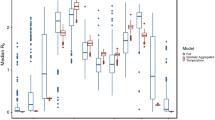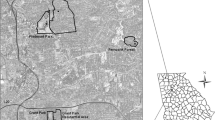Abstract
In the present study, we examined whether bird community composition can predict the annual number of human West Nile virus (WNV) cases on a per county basis in the Colorado Front Range, a region that experienced high numbers of human cases during the early part of the North American epidemic. We analyzed data sets pertaining to birds and human WNV cases from multiple existing databases between the years 2002 and 2008. Based on previous studies that used amplification fractions to compare the relative competence of different bird species, ten bird species that are common in Colorado were selected and categorized as high amplification birds, such as the American Robin (Turdus migratorius), or low amplification birds, such as the American Crow (Corvus brachyrhynchos). A general linear modeling analysis was used with an information theoretic (AIC) model sorting approach to examine which of the models best predicted the number of human WNV cases per county. Candidate models included year as a covariate and one of several bird community descriptors (e.g., richness, diversity, total bird abundance, high amplification abundance, or low amplification abundance). Results demonstrated that high amplification birds were a significant predictor of human WNV cases between 2002 and 2008. Our results suggest that a small subset of the bird community with high amplification fractions may drive the dynamics of human disease risk for West Nile. This study has implications for surveillance of West Nile and may offer insight into disease risk associated with other vector-borne zoonotic diseases.




Similar content being viewed by others
References
Andrews R, Righter R (1992) Colorado Birds: A Reference to their Distribution and Habitat, Denver, CO: Denver Museum of Natural History
BBS (2001) Route location maps: Colorado. http://www.pwrc.usgs.gov/BBS/results/routemaps/routeMapStatic.html. Last modified October 31, 2001 [accessed November 2009]
BBS (2009) Raw Database. https://www.pwrc.usgs.gov/bbs/rawdata. Last modified October 31, 2001 [accessed December 2009]
Blair RB (1996) Land use and avian species diversity along an urban gradient. Ecological Applications 6:506–519.
Bolling BG, Moore CG, Anderson SL, Blair CD, Beaty BJ (2007) Entomological studies along the Colorado Front Range during a period of intense West Nile Virus activity. Journal of the American Mosquito Control Association 23:37–46.
Burnham KP, Anderson DR (2002) Model Selection and Multimodel Inference: A Practical Information-Theoretic Approach, New York: Springer-Verlag.
CDC (2009) Division of Vector-Borne Infectious Diseases: West Nile Virus. http://www.cdc.gov/ncidod/dvbid/westnile/index. [accessed January 4, 2010]
Colorado Department of Public Health and Environment Disease Control (2009) Environmental Epidemiology Division: West Nile Virus. http://www.cdphe.state.c.us/dc/zoonosis/wnv [accessed January 23, 2010]
Hamer GL, Walker ED, Brawn JD, Loss SR, Ruiz MO, Goldberg TL, Schotthoefer AM, Brown WM, Wheeler E, Kitron UD (2008) Rapid amplification of West Nile Virus: the role of hatch-year birds. Vector-borne and Zoonotic Diseases 8:57–67.
Hamer GL, Kitron UD, Goldberg TL, Brawn JD, Loss SR, Ruiz OR, Hayes DB, Walker ED, et al. (2009) Host selection by Culex pipiens mosquitoes and West Nile virus amplification. American Journal of Tropical Medicine and Hygiene 80:268–278.
Jones KE, Patel NG, Levy MA, Storeygard A, Balk D, Gittleman JL, Daszak P, et al. (2008) Global trends in emerging infectious diseases. Nature 451: 990–994. doi:10.1038/nature06536.
Kent R, Juliusson L, Weissmann M, Evans S, Komar N (2009) Seasonal blood-feeding behavior of Culex tarsalis (Diptera: Culicidae) in Weld county, Colorado, 2007. Journal of Medical Entomology 46:380–390.
Kilpatrick AM, Daszak P, Jones MJ, Marra PP, Kramer LD (2006a) Host heterogeneity dominates West Nile virus transmission. Proceedings of the Royal Society Biological Science 273: 2327–2333. doi:10.1098/rspb.2006.3575.
Kilpatrick AM, Kramer LD, Jones MJ, Marra PP, Daszak P (2006b) West Nile virus epidemics in North America are driven by shifts in mosquito feeding behavior. PLoS Biology 4:0606–0609.
Kilpatrick AM, LaDeau SL, Marra PP (2007) Ecology of West Nile virus transmission and its impact on birds in the western hemisphere. The Auk 124:1121–1136.
LoGiudice K, Ostfeld RS, Schmidt KA, Keesing F (2003) The ecology of infectious disease: effects of host diversity and community composition on Lyme disease risk. PNAS 100:567–571.
Loss SR, Hamer GL, Walker ED, Ruiz MO, Goldberg TL, Kitron UD, Brawn JD, et al. (2008) Avian host community structure and prevalence of West Nile virus in Chicago, Illinois. Oecologia 159:415–424. doi:10.1007/s00442-008-1224-6.
Marchetti MP, Light T, Moyle PB, Viers JH (2004) Fish invasions in California watersheds: testing hypothesis using landscape patterns. Ecological Applications 14:1507–1525.
Miller JR, Wiens JA, Hobbs TN, Theobald DM (2003) Effects of human settlement on bird communities in lowland riparian areas of Colorado (USA). Ecological Applications 13:1041–1059.
Nemeth NM, Beckett S, Edwards E, Klenk K, Komar N (2007) Avian mortality surveillance for West Nile virus in Colorado. American Journal of Tropical Medicine and Hygiene 76:431–437.
Pidgeon Am, Radeloff VC, Flather CH, Lepczyk CA, Clayton MK, Hawbaker TJ, Hammer RB, et al. (2007) Associations of forest bird species richness with housing and landscape patterns across the USA. Ecological Applications 17:1989–2010.
Rapport DJ, Daszal P, Froment A, Guegan JF, Lafferty KD, Larigauderie A, Mazumder A, Winding A, et al. (2009) The impact of anthropogenic stress at global and regional scales on biodiversity and human health. In: Biodiversity Change and Human Health From Ecosystem Services to Spread of Disease, Sala OE, Meyerson LA, Parmesan C (editors), Washington DC: Island Press, pp 41–60
Salabanks R, James FC (1999) American robin (Turdus migratorius). In: The Birds of North America, No. 462., Poole A, Gill F (editors), Philadelphia: The Birds of North America, Inc., pp 1–28
Smith TM, Smith LS (2006) Elements of Ecology. San Francisco: Pearson Education Inc.
Thomas MB, Lafferty KD, Friedman CS (2009) Biodiversity and disease. In: Biodiversity Change and Human Health from Ecosystem Services to Spread of Disease, Sala OE, Meyerson LA, Parmesan C (editors), Washington DC: Island Press, pp 229–243
Tuiten W, Koenraadt CJM, McComas K, Harrington LC (2009) The effect of West Nile virus perceptions and knowledge of protective behavior and mosquito breeding in residential yards in upstate New York. EcoHealth 6:42–51. doi:10.1007/s10393-009-0219-z.
United States Census Bureau (2009) People and Households. http://www.census.gov/population. Modified: February 23, 2010 [accessed January 16, 2010]
United States Geological Survey (USGS) Disease Maps West Nile virus (2009) http://diseasemaps.usgs.gov/wnv_us_human.html. USGS. Last modified December 08, 2009 [accessed January 2, 2010]
Wheeler SS, Barker CM, Fang Y, Armijos V, Carroll BD, Husted S, Johnson WO, Reisen WK, et al. (2009) Differential impact of West Nile virus on California birds. The Condor 111:1–20.
Acknowledgments
We thank the North American Breeding Bird Survey, United States Geological Survey, Bureau of Land Management, Centers for Disease Control, U.S. Census Bureau, and the Colorado Department of Public Health and Environment. For assistance with gathering bird data, we thank David Ziolkowski (BBS), for assistance with gathering land use data for Colorado, we thank Lara Juliusson (BLM), and for help with mapmaking, we thank Nicole Nguyen and Ryan Hills. We also thank the University of Colorado’s Ecology and Evolutionary Biology Department Honors Program for which this project served as N. Goulet’s honors thesis. Specifically, we thank Alexander Cruz, Suzanne Nelson, Barbara Demmig-Adams, and Tyler Lansford for helpful insight and suggestions.
Author information
Authors and Affiliations
Corresponding author
Rights and permissions
About this article
Cite this article
McKenzie, V.J., Goulet, N.E. Bird Community Composition Linked to Human West Nile Virus Cases Along the Colorado Front Range. EcoHealth 7, 439–447 (2010). https://doi.org/10.1007/s10393-010-0360-8
Received:
Accepted:
Published:
Issue Date:
DOI: https://doi.org/10.1007/s10393-010-0360-8




